The Chemical Indicator Inks Market is estimated to be valued at USD 84.8 billion in 2025 and is projected to reach USD 174.8 billion by 2035, registering a compound annual growth rate (CAGR) of 7.5% over the forecast period.
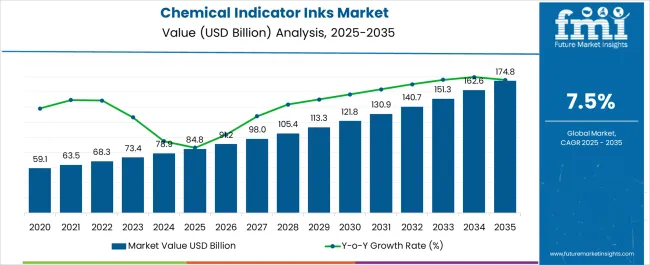
| Metric | Value |
|---|---|
| Chemical Indicator Inks Market Estimated Value in (2025 E) | USD 84.8 billion |
| Chemical Indicator Inks Market Forecast Value in (2035 F) | USD 174.8 billion |
| Forecast CAGR (2025 to 2035) | 7.5% |
The Chemical Indicator Inks market is witnessing steady growth due to rising global demand for sterilization monitoring solutions in healthcare, food packaging, and pharmaceutical sectors. As sterilization processes become more advanced and compliance-driven, the role of indicator inks in ensuring safety, reliability, and quality assurance has become indispensable. Chemical indicator inks are widely used on packaging materials, tapes, and labels to provide visual confirmation of sterilization, enhancing patient safety and regulatory adherence.
Increasing demand from hospitals and pharmaceutical manufacturers is creating new opportunities, particularly with the rising focus on infection prevention and sterile packaging. Technological advancements, such as improved ink formulations with greater sensitivity, durability, and compatibility across sterilization methods, are strengthening adoption. Stringent global regulatory standards and rising emphasis on product safety across supply chains further fuel market expansion.
Additionally, growing usage of single-use medical devices and expanding healthcare infrastructure in emerging economies contribute to rising consumption As sterilization standards tighten and end-user industries pursue robust quality assurance practices, the Chemical Indicator Inks market is projected to sustain significant long-term growth.
The chemical indicator inks market is segmented by sterilization process, product type, printing process, application type, and geographic regions. By sterilization process, chemical indicator inks market is divided into Steam, Ethylene Oxide, Vaporized Hydrogen Peroxide And Plasma, Formaldehyde, and Others. In terms of product type, chemical indicator inks market is classified into Solvent-Based, Water-Based, and UV-Cured. Based on printing process, chemical indicator inks market is segmented into Flexographic Printing, Rotogravure Printing, and Screen Printing. By application type, chemical indicator inks market is segmented into Sterilizing Bags, Bottles, Pre-Fillable Syringes, IV & Blood Containers, Pouches, Thermoformed Trays, Tags And Labels, and Others (Such As Blister Packs). Regionally, the chemical indicator inks industry is classified into North America, Latin America, Western Europe, Eastern Europe, Balkan & Baltic Countries, Russia & Belarus, Central Asia, East Asia, South Asia & Pacific, and the Middle East & Africa.
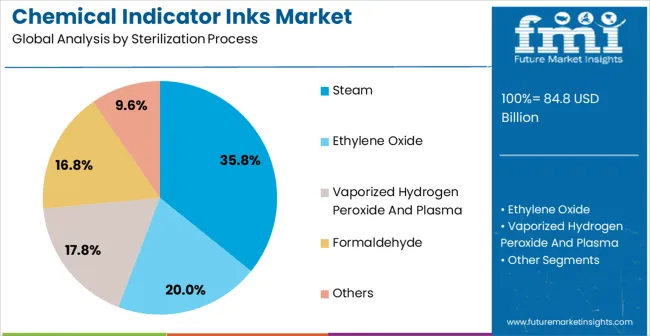
The steam sterilization process segment is expected to account for 35.8% of the Chemical Indicator Inks market revenue in 2025, positioning it as the leading sterilization process type. Its dominance stems from the high adoption of steam sterilization across hospitals, laboratories, and pharmaceutical facilities, where it is recognized as one of the most reliable and cost-effective methods for ensuring sterilization.
Chemical indicator inks used in steam sterilization applications provide clear visual confirmation that adequate conditions of temperature and exposure have been achieved, thereby supporting strict compliance with global sterilization standards. The process is preferred due to its ability to penetrate wrapped instruments and packaging materials, making it ideal for medical device sterilization.
Continuous innovation in ink formulations to improve visibility, resistance, and accuracy under high-moisture conditions has further reinforced market adoption Growing demand for sterilization monitoring in healthcare settings, combined with the effectiveness and widespread availability of steam sterilization systems, is expected to sustain the strong position of this segment in the coming years.
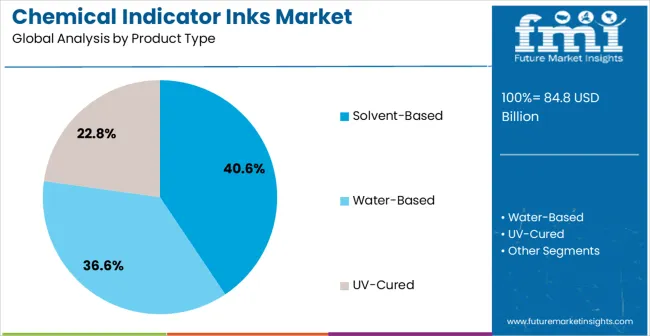
The solvent-based product type segment is projected to hold 40.6% of the market revenue in 2025, making it the leading product category. This leadership is being driven by the superior stability, durability, and performance characteristics of solvent-based inks, which ensure consistent results across a wide range of sterilization processes. These inks are valued for their excellent adhesion to various packaging substrates, including plastics, papers, and foils, which enhances their versatility in medical and pharmaceutical applications.
Solvent-based formulations offer strong resistance to fading and maintain integrity under extreme conditions of heat, moisture, and pressure, ensuring reliable visibility of sterilization indicators. Their widespread availability and cost-effectiveness also make them highly preferred by healthcare and packaging industries.
Ongoing advancements in eco-friendly solvent-based formulations that minimize volatile organic compound emissions are further shaping market preferences As the need for durable, high-performance indicator inks continues to grow across critical end-use sectors, the solvent-based segment is anticipated to maintain its dominance in the global Chemical Indicator Inks market.
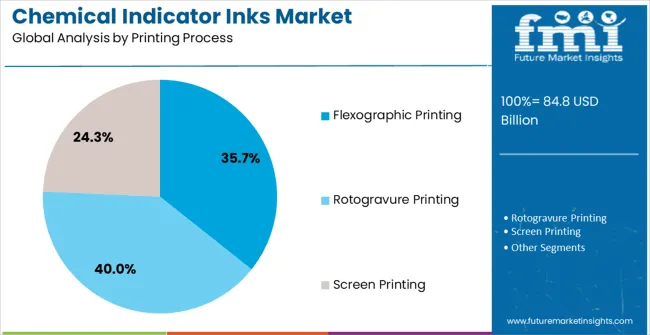
The flexographic printing process segment is anticipated to capture 35.7% of the market revenue in 2025, positioning it as the leading printing process for chemical indicator inks. This dominance is largely attributed to the cost-effectiveness, high-speed production, and adaptability of flexographic printing, which make it highly suitable for large-scale packaging and labeling applications in the medical and pharmaceutical sectors. The process supports a wide variety of substrates, including films, paper, and foils, which are commonly used in sterilization packaging.
Chemical indicator inks applied via flexographic printing demonstrate excellent clarity, precision, and consistency, ensuring that visual indicators remain reliable throughout sterilization cycles. Additionally, the ability to accommodate both water-based and solvent-based inks enhances flexibility for manufacturers, enabling customized solutions.
Technological advancements in flexographic printing equipment, such as improved plate technology and automated systems, are further enhancing efficiency and print quality With rising demand for mass production of sterile medical packaging and labeling, flexographic printing is expected to remain the most widely adopted process, reinforcing its leadership position in the market.
Chemical indicator inks are used for monitoring sterilization process, and form a key component of chemical indicators. They are of the type that change colour in order to indicate successful sterilization of surgical equipment/accessory. When exposed to a specific type of sterilant, at pre-defined temperature conditions, they experience a permanent colour change.
One of the most vital processes carried out in the healthcare industry is the sterilization process. It directly influences safety of the patient as apt sterilization of surgical instruments, equipment and supplies are applied in direct patient care and surgery.
Chemical indicators happen to be primary products that are used to confirm effectiveness of the sterilization process. This not only ensures the effective sterilization of surgical instruments and devices, but also helps assess the level of sterilization achieved.
The chemical indicator inks market is also expected to be driven by the application of chemical indicator inks in the growing food canning industry, where meat, fish and other perishable food items are processed. All these factors make the study of the chemical indicator inks market a vital need.
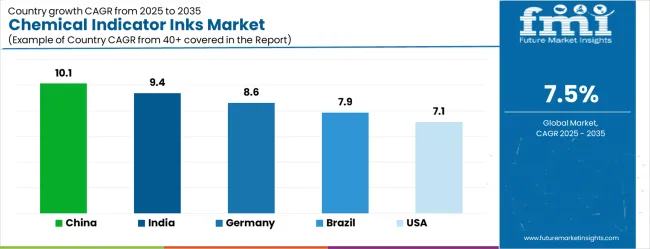
| Country | CAGR |
|---|---|
| China | 10.1% |
| India | 9.4% |
| Germany | 8.6% |
| Brazil | 7.9% |
| USA | 7.1% |
| UK | 6.4% |
| Japan | 5.6% |
The Chemical Indicator Inks Market is expected to register a CAGR of 7.5% during the forecast period, exhibiting varied country level momentum. China leads with the highest CAGR of 10.1%, followed by India at 9.4%. Developed markets such as Germany, France, and the UK continue to expand steadily, while the USA is likely to grow at consistent rates. Japan posts the lowest CAGR at 5.6%, yet still underscores a broadly positive trajectory for the global Chemical Indicator Inks Market. In 2024, Germany held a dominant revenue in the Western Europe market and is expected to grow with a CAGR of 8.6%. The USA Chemical Indicator Inks Market is estimated to be valued at USD 30.4 billion in 2025 and is anticipated to reach a valuation of USD 30.4 billion by 2035. Sales are projected to rise at a CAGR of 0.0% over the forecast period between 2025 and 2035. While Japan and South Korea markets are estimated to be valued at USD 4.0 billion and USD 2.5 billion respectively in 2025.
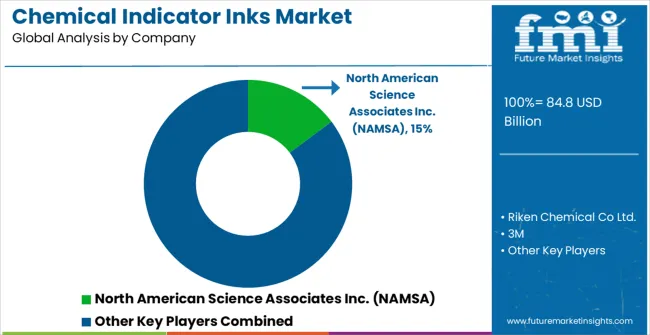
| Item | Value |
|---|---|
| Quantitative Units | USD 84.8 Billion |
| Sterilization Process | Steam, Ethylene Oxide, Vaporized Hydrogen Peroxide And Plasma, Formaldehyde, and Others |
| Product Type | Solvent-Based, Water-Based, and UV-Cured |
| Printing Process | Flexographic Printing, Rotogravure Printing, and Screen Printing |
| Application Type | Sterilizing Bags, Bottles, Pre-Fillable Syringes, IV & Blood Containers, Pouches, Thermoformed Trays, Tags And Labels, and Others (Such As Blister Packs) |
| Regions Covered | North America, Europe, Asia-Pacific, Latin America, Middle East & Africa |
| Country Covered | United States, Canada, Germany, France, United Kingdom, China, Japan, India, Brazil, South Africa |
| Key Companies Profiled | North American Science Associates Inc. (NAMSA), Riken Chemical Co Ltd., 3M, Tempil (LA-Co Industries), NiGK Corporation, SteriTec Products Inc., Propper Manufacturing Company, Inc., ETIGAM BV, Terragene SA, GKE GmbH, and STERIS Corporation |
The global chemical indicator inks market is estimated to be valued at USD 84.8 billion in 2025.
The market size for the chemical indicator inks market is projected to reach USD 174.8 billion by 2035.
The chemical indicator inks market is expected to grow at a 7.5% CAGR between 2025 and 2035.
The key product types in chemical indicator inks market are steam, ethylene oxide, vaporized hydrogen peroxide and plasma, formaldehyde and others.
In terms of product type, solvent-based segment to command 40.6% share in the chemical indicator inks market in 2025.






Our Research Products

The "Full Research Suite" delivers actionable market intel, deep dives on markets or technologies, so clients act faster, cut risk, and unlock growth.

The Leaderboard benchmarks and ranks top vendors, classifying them as Established Leaders, Leading Challengers, or Disruptors & Challengers.

Locates where complements amplify value and substitutes erode it, forecasting net impact by horizon

We deliver granular, decision-grade intel: market sizing, 5-year forecasts, pricing, adoption, usage, revenue, and operational KPIs—plus competitor tracking, regulation, and value chains—across 60 countries broadly.

Spot the shifts before they hit your P&L. We track inflection points, adoption curves, pricing moves, and ecosystem plays to show where demand is heading, why it is changing, and what to do next across high-growth markets and disruptive tech

Real-time reads of user behavior. We track shifting priorities, perceptions of today’s and next-gen services, and provider experience, then pace how fast tech moves from trial to adoption, blending buyer, consumer, and channel inputs with social signals (#WhySwitch, #UX).

Partner with our analyst team to build a custom report designed around your business priorities. From analysing market trends to assessing competitors or crafting bespoke datasets, we tailor insights to your needs.
Supplier Intelligence
Discovery & Profiling
Capacity & Footprint
Performance & Risk
Compliance & Governance
Commercial Readiness
Who Supplies Whom
Scorecards & Shortlists
Playbooks & Docs
Category Intelligence
Definition & Scope
Demand & Use Cases
Cost Drivers
Market Structure
Supply Chain Map
Trade & Policy
Operating Norms
Deliverables
Buyer Intelligence
Account Basics
Spend & Scope
Procurement Model
Vendor Requirements
Terms & Policies
Entry Strategy
Pain Points & Triggers
Outputs
Pricing Analysis
Benchmarks
Trends
Should-Cost
Indexation
Landed Cost
Commercial Terms
Deliverables
Brand Analysis
Positioning & Value Prop
Share & Presence
Customer Evidence
Go-to-Market
Digital & Reputation
Compliance & Trust
KPIs & Gaps
Outputs
Full Research Suite comprises of:
Market outlook & trends analysis
Interviews & case studies
Strategic recommendations
Vendor profiles & capabilities analysis
5-year forecasts
8 regions and 60+ country-level data splits
Market segment data splits
12 months of continuous data updates
DELIVERED AS:
PDF EXCEL ONLINE
Steam Chemical Indicator Market
Biological and Chemical Indicators Market Insights - Trends, Growth & Forecast 2025 to 2035
Chemical Hydraulic Valves Market Size and Share Forecast Outlook 2025 to 2035
Chemical Vapor Deposition Market Forecast Outlook 2025 to 2035
Chemical Recycling Service Market Forecast Outlook 2025 to 2035
Chemical Dosing Equipment Market Size and Share Forecast Outlook 2025 to 2035
Chemical Filling System Market Size and Share Forecast Outlook 2025 to 2035
Chemical Absorbent Pads Market Size and Share Forecast Outlook 2025 to 2035
Chemical Boiler Market Size and Share Forecast Outlook 2025 to 2035
Chemical Hardener Compounds Market Size and Share Forecast Outlook 2025 to 2035
Chemical Anchors Market Size and Share Forecast Outlook 2025 to 2035
Chemical Peel Market Size and Share Forecast Outlook 2025 to 2035
Chemical Protective Gloves Market Size and Share Forecast Outlook 2025 to 2035
Chemical Injection Pump Market Size and Share Forecast Outlook 2025 to 2035
Chemical Liquid Hydrogen Market Size and Share Forecast Outlook 2025 to 2035
Chemical Sensors Market Size and Share Forecast Outlook 2025 to 2035
Chemical Resistant EVA Film Market Size and Share Forecast Outlook 2025 to 2035
Chemical Resistant Fabrics Market Size and Share Forecast Outlook 2025 to 2035
Chemical Resistant Coating Market Size and Share Forecast Outlook 2025 to 2035
Chemical Distribution Market Size and Share Forecast Outlook 2025 to 2035

Thank you!
You will receive an email from our Business Development Manager. Please be sure to check your SPAM/JUNK folder too.
Chat With
MaRIA